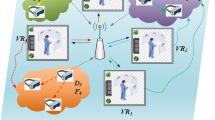Abstract
Fog radio access networks (F-RANs), in which the fog access points are equipped with communication, caching, and computing functionalities, have been anticipated as a promising architecture for enabling virtual reality (VR) applications in wireless networks. Although extensive research efforts have been devoted to designing efficient resource allocation strategies for realizing successful mobile VR delivery in downlink, the equally important resource allocation problem of mobile VR delivery in uplink has so far drawn little attention. In this work, we investigate a mobile VR F-RAN delivery framework, where both the uplink and downlink transmissions are considered. We first characterize the round-trip latency of the system, which reveals its dependence on the communication, caching, and computation resource allocations. Based on this information, we propose a simple yet efficient algorithm to minimize the round-trip latency, while satisfying the practical constraints on caching, computation capability, and transmission capacity in the uplink and downlink. Numerical results show that our proposed algorithm can effectively reduce the round-trip latency compared with various baselines, and the impacts of communication, caching, and computing resources on latency performance are illustrated.
摘要
雾无线接入网络(F-RAN)中,雾接入节点上部署了通信、缓存和计算功能,因此,F-RAN被认为是一种可使能移动虚拟现实(VR)应用的无线网络架构。为实现移动VR分发,高效的下行资源分配策略已被广泛研究,但同样重要的VR分发上行资源分配问题至今少有关注。本文研究了基于F-RAN的移动VR分发框架,并同时考虑上行和下行传输的影响。首先,通过刻画系统往返时延,揭示了通信、缓存和计算资源的影响。在此基础上,考虑缓存和计算容量以及上行和下行链路传输容量的约束,提出一种简单高效的往返时延最小化算法。仿真结果表明,与其他基准方法相比,本文所提算法可有效降低往返时延;阐明了通信、缓存和计算资源对往返时延性能的影响。
Similar content being viewed by others
References
Bastug E, Bennis M, Medard M, et al., 2017. Toward interconnected virtual reality: opportunities, challenges, and enablers. IEEE Commun Mag, 55(6):110–117. https://doi.org/10.1109/MCOM.2017.1601089
Boyd S, Mattingley J, 2018. Branch and Bound Methods. Stanford University, Stanford, USA.
Chen MZ, Semiari O, Saad W, et al., 2020. Federated echo state learning for minimizing breaks in presence in wireless virtual reality networks. IEEE Trans Wirel Commun, 19(1):177–191. https://doi.org/10.1109/TWC.2019.2942929
Chiu TC, Pang AC, Chung WH, et al., 2019. Latency-driven fog cooperation approach in fog radio access networks. IEEE Trans Serv Comput, 12(5):698–711. https://doi.org/10.1109/TSC.2018.2858253
Cisco System, 2019. Cisco Visual Networking Index: Global Mobile Data Traffic Forecast Update, 2017–2020. White Paper.
Dai JM, Zhang ZL, Mao SW, et al., 2020. A view synthesis-based 360° VR caching system over MEC-enabled C-RAN. IEEE Trans Circ Syst Video Technol, 30(10):3843–3855. https://doi.org/10.1109/TCSVT.2019.2946755
Dang T, Peng MG, 2019. Joint radio communication, caching, and computing design for mobile virtual reality delivery in fog radio access networks. IEEE J Sel Areas Commun, 37(7):1594–1607. https://doi.org/10.1109/JSAC.2019.2916486
Du JB, Yu FR, Lu GY, et al., 2020. MEC-assisted immersive VR video streaming over terahertz wireless networks: a deep reinforcement learning approach. IEEE Int Things J, 7(10):9517–9529. https://doi.org/10.1109/JIOT.2020.3003449
Hu FH, Deng YS, Saad W, et al., 2020. Cellular-connected wireless virtual reality: requirements, challenges, and solutions. IEEE Commun Mag, 58(5):105–111. https://doi.org/10.1109/MCOM.001.1900511
Huang HC, Liu B, Chen L, et al., 2018. D2D-assisted VR video pre-caching strategy. IEEE Access, 6:61886–61895. https://doi.org/10.1109/ACCESS.2018.2868766
Liu YM, Yu FR, Li X, et al., 2018. Distributed resource allocation and computation offloading in fog and cloud networks with non-orthogonal multiple access. IEEE Trans Veh Technol, 67(12):12137–12151. https://doi.org/10.1109/TVT.2018.2872912
Nelder JA, Mead R, 1965. A simplex method for function minimization. Comput J, 7(4):308–313. https://doi.org/10.1093/comjnl/7.4.308
Park J, Popovski P, Simeone O, 2018. Minimizing latency to support VR social interactions over wireless cellular systems via bandwidth allocation. IEEE Wirel Commun Lett, 7(5):776–779. https://doi.org/10.1109/LWC.2018.2823761
Park SH, Simeone O, Shitz SS, 2016. Joint optimization of cloud and edge processing for fog radio access networks. IEEE Trans Wirel Commun, 15(11):7621–7632. https://doi.org/10.1109/TWC.2016.2605104
Peng MG, Yan S, Zhang KC, et al., 2016. Fog-computing-based radio access networks: issues and challenges. IEEE Netw, 30(4):46–53. https://doi.org/10.1109/MNET.2016.7513863
Sun YP, Chen ZY, Tao MX, et al., 2019. Communications, caching, and computing for mobile virtual reality: modeling and tradeoff. IEEE Trans Commun, 67(11):7573–7586. https://doi.org/10.1109/TCOMM.2019.2920594
Yoshihara T, Fujita S, 2019. Fog-assisted virtual reality MMOG with ultra low latency. 7th Int Symp on Computing and Networking, p.121–129. https://doi.org/10.1109/CANDAR.2019.00022
You D, Doan TV, Torre R, et al., 2019. Fog computing as an enabler for immersive media: service scenarios and research opportunities. IEEE Access, 7:65797–65810. https://doi.org/10.1109/ACCESS.2019.2917291
Zhang P, Peng MG, Cui SG, et al., 2022. Theory and techniques for “intellicise” wireless networks. Front Inform Technol Electron Eng, 23(1):1–4. https://doi.org/10.1631/FITEE.2210000
Zhang Y, Jiao L, Yan JY, et al., 2019. Dynamic service placement for virtual reality group gaming on mobile edge cloudlets. IEEE J Sel Areas Commun, 37(8):1881–1897. https://doi.org/10.1109/JSAC.2019.2927071
Zhou Y, Pan CH, Yeoh PL, et al., 2021. Communication-and-computing latency minimization for UAV-enabled virtual reality delivery systems. IEEE Trans Commun, 69(3):1723–1735. https://doi.org/10.1109/TCOMM.2020.3040283
Zipf GK, 1929. Relative Frequency as a Determinant of Phonetic Change. PhD Thesis, Harvard University, Cambridge, USA.
Author information
Authors and Affiliations
Contributions
Tian DANG carried out the analysis of the resource allocation optimization and drafted the paper. Chenxi LIU modeled the system and designed the algorithms. Xiqing LIU performed the simulations and helped organize the paper. Shi YAN helped with the optimization analysis and simulations. Tian DAN and Chenxi LIU revised and finalized the paper.
Corresponding author
Additional information
Compliance with ethics guidelines
Tian DANG, Chenxi LIU, Xiqing LIU, and Shi YAN declare that they have no conflict of interest.
Project supported by the Beijing Natural Science Foundation, China (No. JQ18016), the National Key R&D Program of China (No. 2020YFB1806703), the National Natural Science Foundation of China (Nos. 62001047, 61901315, and 61901044), the National Program for Special Support of Eminent Professionals, China, the Young Elite Scientist Sponsorship Program by China Institute of Communications, and the Project of China Railway Corporation (No. P2020G004)
Rights and permissions
About this article
Cite this article
Dang, T., Liu, C., Liu, X. et al. Joint uplink and downlink resource allocation for low-latency mobile virtual reality delivery in fog radio access networks. Front Inform Technol Electron Eng 23, 73–85 (2022). https://doi.org/10.1631/FITEE.2100308
Received:
Accepted:
Published:
Issue Date:
DOI: https://doi.org/10.1631/FITEE.2100308




